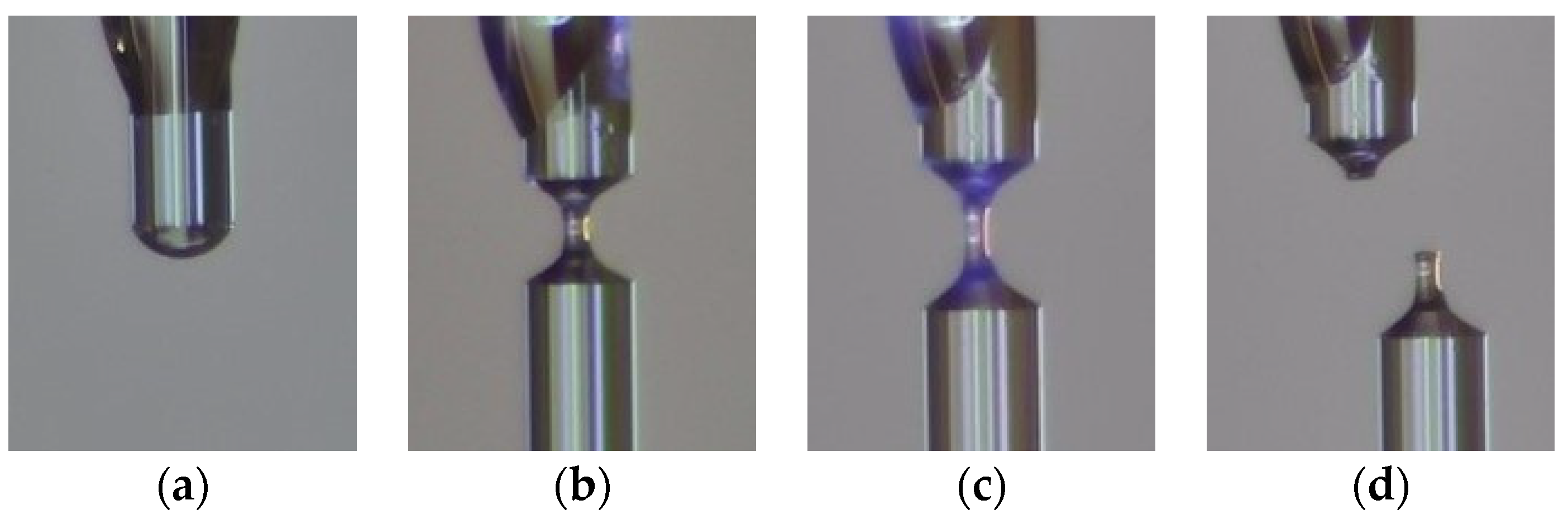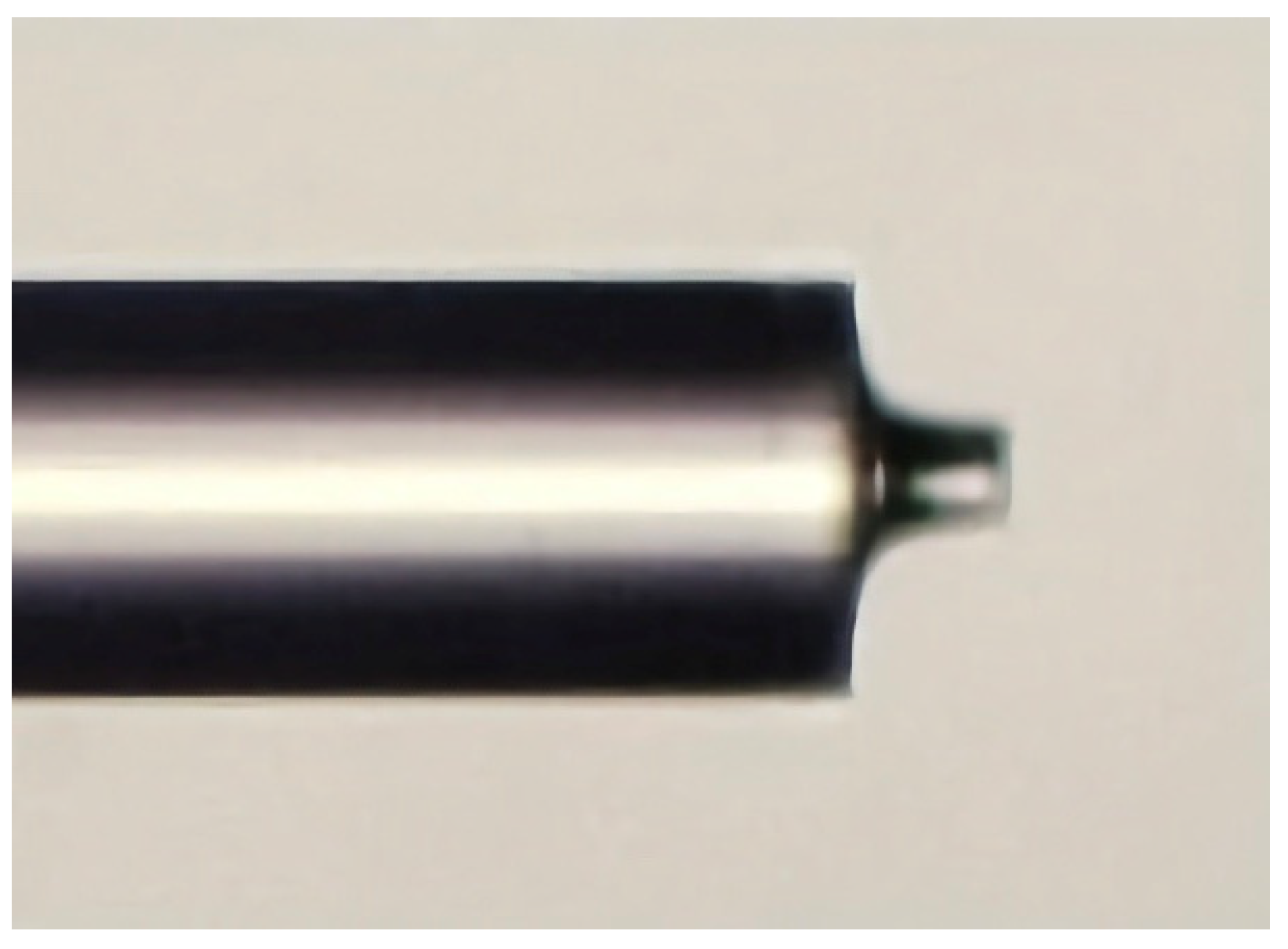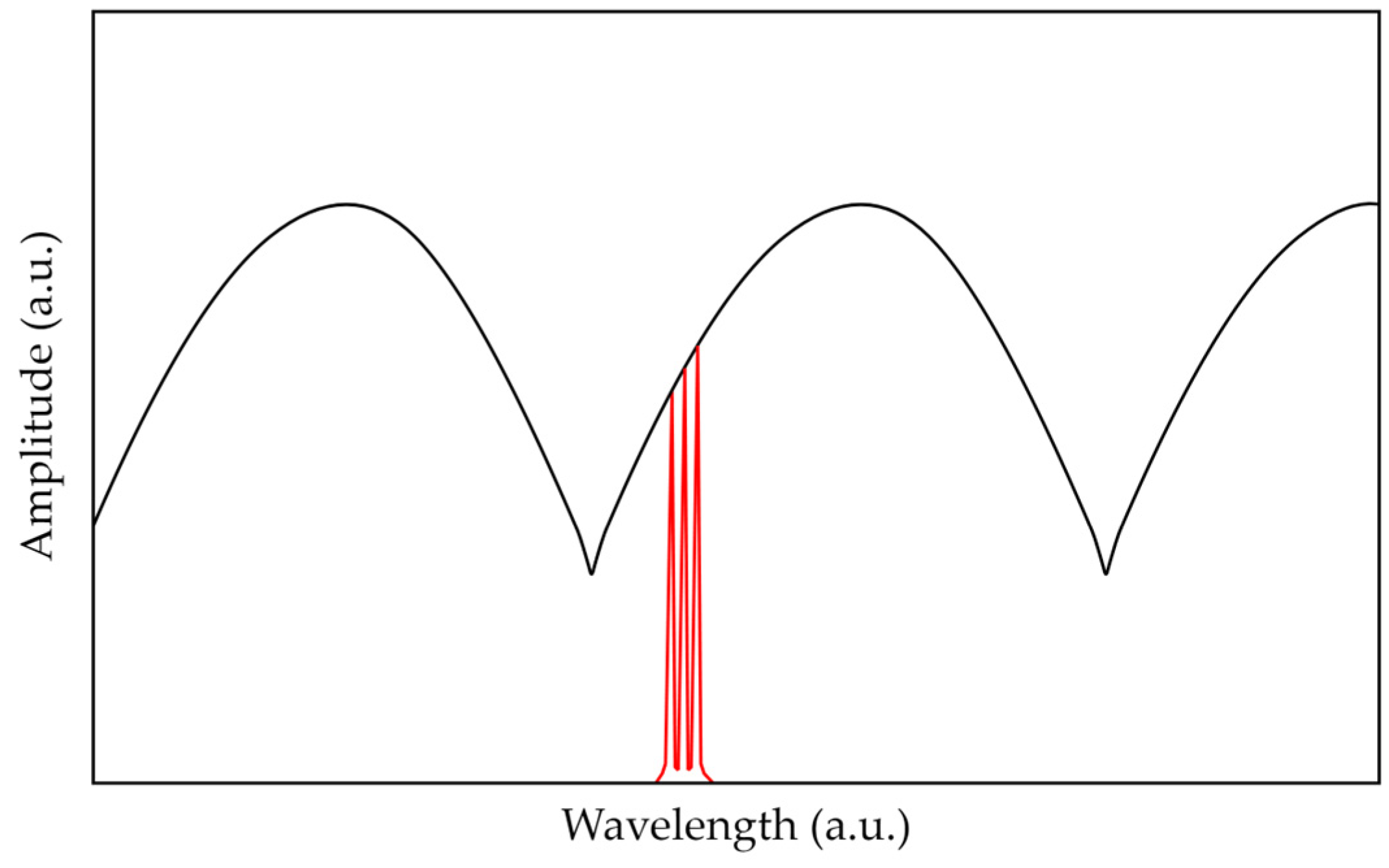Microscopic Temperature Sensor Based on End-Face Fiber-Optic Fabry–Perot Interferometer
Abstract
:1. Introduction
2. The Formation of the Sensitive Element
3. The Mathematical Modeling of the Sensing Element
3.1. Method for Sensing Element Modeling
3.2. Modeling Results
4. Temperature Tests
5. Ensuring High Interrogation Speed at Low Cost of Sensor System
6. Discussion and Conclusions
Author Contributions
Funding
Institutional Review Board Statement
Informed Consent Statement
Data Availability Statement
Conflicts of Interest
References
- Schena, E.; Tosi, D.; Saccomandi, P.; Lewis, E.; Kim, T. Fiber Optic Sensors for Temperature Monitoring during Thermal Treatments: An Overview. Sensors 2016, 16, 1144. [Google Scholar] [CrossRef]
- Sugino, M.; Ogata, M.; Mizuno, K.; Hasegawa, H. Development of Zinc Coating Methods on Fiber Bragg Grating Temperature Sensors. IEEE Trans. Appl. Supercond. 2016, 26, 9000606. [Google Scholar] [CrossRef]
- Ben Hassen, R.; Caucheteur, C.; Delchambre, A. FBGs Temperature Sensor for Electrosurgical Knife Subject to High Voltage and High-Frequency Current. In Optical Sensing and Detection VI; Berghmans, F., Mignani, A.G., Eds.; SPIE: Bellingham, WA, USA, 2020; Volume 11354. [Google Scholar]
- El-Gammal, H.M.; El-Badawy, E.-S.A.; Rizk, M.R.M.; Aly, M.H. A New Hybrid FBG with a π-Shift for Temperature Sensing in Overhead High Voltage Transmission Lines. Opt. Quantum Electron. 2020, 52, 53. [Google Scholar] [CrossRef]
- Liu, T.; Chen, Y.; Han, Q.; Liu, F.; Yao, Y. Sensor Based on Macrobent Fiber Bragg Grating Structure for Simultaneous Measurement of Refractive Index and Temperature. Appl. Opt. 2016, 55, 791. [Google Scholar] [CrossRef] [PubMed]
- Agliullin, T.; Il’In, G.; Kuznetsov, A.; Misbakhov, R.; Misbakhov, R.; Morozov, G.; Morozov, O.; Nureev, I.; Sakhabutdinov, A. Overview of Addressed Fiber Bragg Structures’ Development. Photonics 2023, 10, 175. [Google Scholar] [CrossRef]
- Fadeev, K.M.; Larionov, D.D.; Zhikina, L.A.; Minkin, A.M.; Shevtsov, D.I. A Fiber-Optic Sensor for Simultaneous Temperature and Pressure Measurements Based on a Fabry–Perot Interferometer and a Fiber Bragg Grating. Instrum. Exp. Tech. 2020, 63, 543–546. [Google Scholar] [CrossRef]
- Wang, X.; Li, B.; Xiao, Z.; Lee, S.H.; Roman, H.; Russo, O.L.; Chin, K.K.; Farmer, K.R. An Ultra-Sensitive Optical MEMS Sensor for Partial Discharge Detection. J. Micromech. Microeng. 2004, 15, 521. [Google Scholar] [CrossRef]
- Rong, Q.; Sun, H.; Qiao, X.; Zhang, J.; Hu, M.; Feng, Z. Corrigendum: A Miniature Fiber-Optic Temperature Sensor Based on a Fabry–Perot Interferometer. J. Opt. 2012, 14, 059501. [Google Scholar] [CrossRef]
- Lee, C.E.; Taylor, H.F. Fiber-Optic Fabry–Perot Temperature Sensor Using a Low-Coherence Light Source. J. Light. Technol. 1991, 9, 129–134. [Google Scholar] [CrossRef]
- Wang, Y.; Li, Y.; Liao, C.; Wang, D.N.; Yang, M.; Lu, P. High-Temperature Sensing Using Miniaturized Fiber In-Line Mach–Zehnder Interferometer. IEEE Photon. Technol. Lett. 2010, 22, 39–41. [Google Scholar] [CrossRef]
- Yuan, L.; Wei, T.; Han, Q.; Wang, H.; Huang, J.; Jiang, L.; Xiao, H. Fiber Inline Michelson Interferometer Fabricated by a Femtosecond Laser. Opt. Lett. 2012, 37, 4489–4491. [Google Scholar] [CrossRef] [PubMed]
- Yang, M.; Peng, J.; Wang, G.; Dai, J. Fiber Optic Sensors Based on Nano-Films. In Fiber Optic Sensors; Smart Sensors, Measurement and Instrumentation; Matias, I.R., Ikezawa, S., Corres, J., Eds.; Springer International Publishing: Cham, Switzerland, 2017; Volume 21, pp. 1–30. ISBN 978-3-319-42624-2. [Google Scholar]
- Chen, Z.; Xiong, S.; Gao, S.; Zhang, H.; Wan, L.; Huang, X.; Huang, B.; Feng, Y.; Liu, W.; Li, Z. High-Temperature Sensor Based on Fabry–Perot Interferometer in Microfiber Tip. Sensors 2018, 18, 202. [Google Scholar] [CrossRef]
- Li, J.; Jia, P.; Fang, G.; Wang, J.; Qian, J.; Ren, Q.; Xiong, J. Batch-Producible All-Silica Fiber-Optic Fabry–Perot Pressure Sensor for High-Temperature Applications up to 800 °C. Sens. Actuators A Phys. 2022, 334, 113363. [Google Scholar] [CrossRef]
- Wu, C.; Fu, H.Y.; Qureshi, K.K.; Guan, B.-O.; Tam, H.Y. High-Pressure and High-Temperature Characteristics of a Fabry–Perot Interferometer Based on Photonic Crystal Fiber. Opt. Lett. 2011, 36, 412–414. [Google Scholar] [CrossRef]
- Ferreira, M.S.; Coelho, L.; Schuster, K.; Kobelke, J.; Santos, J.L.; Frazão, O. Fabry–Perot Cavity Based on a Diaphragm-Free Hollow-Core Silica Tube. Opt. Lett. 2011, 36, 4029. [Google Scholar] [CrossRef] [PubMed]
- Zhu, Y.; Kang, J.; Sang, T.; Dong, X.; Zhao, C. Hollow Fiber-Based Fabry–Perot Cavity for Liquid Surface Tension Measurement. Appl. Opt. 2014, 53, 7814–7818. [Google Scholar] [CrossRef]
- Liu, G.; Han, M.; Hou, W. High-Resolution and Fast-Response Fiber-Optic Temperature Sensor Using Silicon Fabry-Pérot Cavity. Opt. Express 2015, 23, 7237–7247. [Google Scholar] [CrossRef]
- Hou, L.; Zhao, C.; Xu, B.; Mao, B.; Shen, C.; Wang, D.N. Highly Sensitive PDMS-Filled Fabry–Perot Interferometer Temperature Sensor Based on the Vernier Effect. Appl. Opt. 2019, 58, 4858–4865. [Google Scholar] [CrossRef]
- Zhang, J.; Liao, H.; Lu, P.; Jiang, X.; Fu, X.; Ni, W.; Liu, D.; Zhang, J. Ultrasensitive Temperature Sensor with Cascaded Fiber Optic Fabry–Perot Interferometers Based on Vernier Effect. IEEE Photonics J. 2018, 10, 6803411. [Google Scholar] [CrossRef]
- Cao, K.; Liu, Y.; Qu, S. Compact Fiber Biocompatible Temperature Sensor Based on a Hermetically-Sealed Liquid-Filling Structure. Opt. Express 2017, 25, 29597–29604. [Google Scholar] [CrossRef]
- Kersey, A.D.; Davis, M.A.; Patrick, H.J.; LeBlanc, M.; Koo, K.P.; Askins, C.G.; Putnam, M.A.; Friebele, E.J. Fiber Grating Sensors. J. Light. Technol. 1997, 15, 1442–1463. [Google Scholar] [CrossRef]
- Fajkus, M.; Nedoma, J.; Martinek, R.; Vasinek, V.; Nazeran, H.; Siska, P. A Non-Invasive Multichannel Hybrid Fiber-Optic Sensor System for Vital Sign Monitoring. Sensors 2017, 17, 111. [Google Scholar] [CrossRef]
- Mohammed, P.A.; Wadsworth, W.J. Long Free-Standing Polymer Waveguides Fabricated Between Single-Mode Optical Fiber Cores. J. Light. Technol. 2015, 33, 4384–4389. [Google Scholar] [CrossRef]
- Német, N.; White, D.; Kato, S.; Parkins, S.; Aoki, T. Transfer-Matrix Approach to Determining the Linear Response of All-Fiber Networks of Cavity-QED Systems. Phys. Rev. Appl. 2020, 13, 064010. [Google Scholar] [CrossRef]
- Marcuse, D. Theory of Dielectric Optical Waveguides; Academic Press: Cambridge, MA, USA, 1991; ISBN 978-0-12-470951-5. [Google Scholar]
- Hussein, S.M.R.H.; Sakhabutdinov, A.Z.; Morozov, O.G.; Anfinogentov, V.I.; Tunakova, J.A.; Shagidullin, A.R.; Kuznetsov, A.A.; Lipatnikov, K.A.; Nasybullin, A.R. Applicability Limits of the End Face Fiber-Optic Gas Concentration Sensor, Based on Fabry–Perot Interferometer. Karbala Int. J. Mod. Sci. 2022, 8, 339–355. [Google Scholar] [CrossRef]
- Ma, W.; Xing, J.; Wang, R.; Rong, Q.; Zhang, W.; Li, Y.; Zhang, J.; Qiao, X. Optical Fiber Fabry–Perot Interferometric CO2 Gas Sensor Using Guanidine Derivative Polymer Functionalized Layer. IEEE Sens. J. 2018, 18, 1924–1929. [Google Scholar] [CrossRef]
- Makarov, R.; Qaid, M.R.T.M.; Al Hussein, A.N.; Valeev, B.; Agliullin, T.; Anfinogentov, V.; Sakhabutdinov, A. Enhancing Microwave Photonic Interrogation Accuracy for Fiber-Optic Temperature Sensors via Artificial Neural Network Integration. Optics 2024, 5, 223–237. [Google Scholar] [CrossRef]










| Sensor | Length, μm | Lateral Dimension, μm | Sensitivity, pm/°C | Reference |
|---|---|---|---|---|
| Fiber Bragg grating | ~1 × 103–1 × 104 | 125 | ~10 | [23,24] |
| Microfiber tip FPI | ~60–360 | ~30 | ~14 | [14] |
| Silicon pillar FPI | ~200 | ~80 | ~85 | [19] |
| FPI based on hollow fiber with PDMS | ~34 + 138 | ~130 | ~650 * | [20] |
| Cascaded FPI with NOA65 | ~78 + 84 | ~150 | ~2.87 × 103 * | [21] |
| Ethanol-filled FPI | ~24–45 + 150 | ~125 | ~430 | [22] |
| Proposed sensor | ~40–90 | ~20–50 | ~44 | – |
| Parameter | Value |
|---|---|
| Refractive index of the optical fiber (n1), RIU | 1.4587 |
| Refractive index of the interferometer cavity (n2), RIU | 1.59 |
| Length of the interferometer cavity (H0), m | 51.22 × 10−6 |
| Thermo-optic coefficient of the optical fiber (dn1/dT), °C−1 | 8.6 × 10−6 |
| Thermo-optic coefficient of the interferometer cavity (dn2/dT), °C−1 | −1.87 × 10−4 |
| Thermal expansion coefficient of the interferometer cavity (α), °C−1 | 1.6 × 10−4 |
| No. of ANN | No. of Hidden Layers | No. of Neurons in Each Hidden Layer | MAE, °C |
|---|---|---|---|
| (1) | 1 | 50 | 5 |
| (2) | 1 | 200 | 4 |
| (3) | 2 | 50/20 | 3.5 |
| (4) | 2 | 100/50 | 3 |
| (5) | 3 | 50/20/20 | 2 |
| (6) | 3 | 150/100/50 | 1.5 |
| (7) | 4 | 300/200/150/100 | 0.3 |
| (8) | 5 | 800/500/400/300/150 | 0.008 |
| (9) | 5 | 1500/1200/1000/500/400 | 0.002 |
| Range, °C | MAE, °C | MRPE, % |
|---|---|---|
| from 23 to 52 | 0.03214 | 0.06459 |
| from 24 to 51 | 0.01542 | 0.02172 |
| from 25 to 50 | 0.008358 | 0.018271 |
| from 26 to 49 | 0.00378 | 0.00912 |
| from 27 to 48 | 0.002372 | 0.00662 |
Disclaimer/Publisher’s Note: The statements, opinions and data contained in all publications are solely those of the individual author(s) and contributor(s) and not of MDPI and/or the editor(s). MDPI and/or the editor(s) disclaim responsibility for any injury to people or property resulting from any ideas, methods, instructions or products referred to in the content. |
© 2024 by the authors. Licensee MDPI, Basel, Switzerland. This article is an open access article distributed under the terms and conditions of the Creative Commons Attribution (CC BY) license (https://creativecommons.org/licenses/by/4.0/).
Share and Cite
Chesnokova, M.; Nurmukhametov, D.; Ponomarev, R.; Agliullin, T.; Kuznetsov, A.; Sakhabutdinov, A.; Morozov, O.; Makarov, R. Microscopic Temperature Sensor Based on End-Face Fiber-Optic Fabry–Perot Interferometer. Photonics 2024, 11, 712. https://doi.org/10.3390/photonics11080712
Chesnokova M, Nurmukhametov D, Ponomarev R, Agliullin T, Kuznetsov A, Sakhabutdinov A, Morozov O, Makarov R. Microscopic Temperature Sensor Based on End-Face Fiber-Optic Fabry–Perot Interferometer. Photonics. 2024; 11(8):712. https://doi.org/10.3390/photonics11080712
Chicago/Turabian StyleChesnokova, Maria, Danil Nurmukhametov, Roman Ponomarev, Timur Agliullin, Artem Kuznetsov, Airat Sakhabutdinov, Oleg Morozov, and Roman Makarov. 2024. "Microscopic Temperature Sensor Based on End-Face Fiber-Optic Fabry–Perot Interferometer" Photonics 11, no. 8: 712. https://doi.org/10.3390/photonics11080712






